The following settings need to be configured to set up the finance functions to process GST.
Financial Configuration - General tab
Opening the Finance Configuration - General tab
To open the General tab:
- Select Module > System > Finance Configuration Maintenance from the main menu. See Synergetic Financial Configuration - General tab.
The General tab of the Synergetic Financial Configuration window is displayed.
.gif)
Field | Description |
|---|
Tax On Income Control Account | Tax included in postings to income accounts, including asset sales, is posted to this account. |
Tax On Expenses Control Account | Tax included in postings to expense accounts or asset purchases is posted to this account. |
Tax Control Account | When the BAS is processed the Tax On Income and Tax On Expense Control accounts are transferred to the Tax Control account (awaiting payment to, or refund from, the taxation office). |
Tax Withheld Control Account | Tax withheld from suppliers not quoting ABN (Australian Business Number) is transferred to this account. |
Last BAS Posting Date | This field is automatically populated with the date when the BAS statement is processed. It cannot be changed here. |
General Ledger Maintenance
Opening the General Ledger Maintenance - General tab
To open the General tab:
- Select Module > General Ledger > General Ledger Maintenance from the main menu. See General Ledger Maintenance - General tab in the General ledger manual.
- Search for the general ledger accounts to update. See Searching for general ledger accounts in the General ledger manual.
The General tab of the General Ledger Maintenance window is displayed.

Field | Description |
|---|
Tax Code | See values in the luTax lookup table, as discussed below. Normal values include: - GST Free (F).
- Inclusive of tax. For example:
- 10% GST (10) in Australia
- 15% GST (15) in New Zealand.
- Assets, inclusive of tax. For example:
- Assets - 10% GST (AST) in Australia
- Assets - 15% GST (AST) in New Zealand.
- Input Taxed (I).
Note: Tax control accounts require Tax Code is Fixed in order to process the BAS.
|
Tax Code is Fixed | Select to prevent staff members changing the tax codes on accounts. If your accounts policy is to only code general ledger accounts against supplier invoices and not to also code tax effect, then select this option.
Note: This will probably require a considerable expansion of the Chart of Accounts. |
Lookup Table Maintenance - Finance
Opening the luTax lookup table
To open the luTax lookup table:
- Select Module > System > Lookup Table Maintenance - Finance from the main menu.
- Select the luTax in the Table Name column.
The luTax lookup table is displayed.
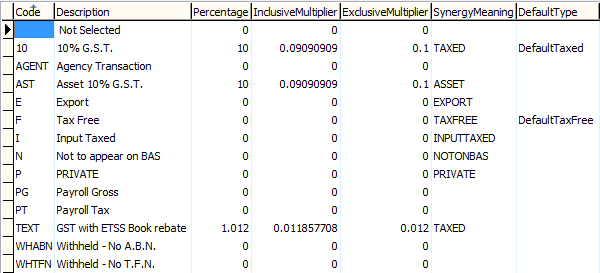
Field | Description |
|---|
Table description | Note that these values are automatically set up for GST. |
Code | Short code to identify the tax treatment. |
Description | For easy selection from lookup lists. |
Percentage | Tax percentage. |
Inclusive Multiplier | Value that the tax inclusive invoice line item amount is to be multiplied by to obtain the tax amount. In: - Australia a multiplier of 0.09090909 gives a tax rate of 10%
- New Zealand a multiplier of 0.86956522 gives a tax rate of 15%.
|
Exclusive multiplier | Value that the invoice line item amount is to be multiplied by to obtain the tax amount.
This applies to amounts that do not include tax but the line item is subject to tax. |
Debtor Fee Maintenance - General Ledger tab
Opening the Debtor Fee Maintenance - General Ledger tab
To open the General Ledger tab:
- Select Module > Debtors > Fee Maintenance from the main menu. See Debtor Fee Maintenance - General Ledger tab in the Debtors manual.
- Search for the fees to update.
The General Ledger tab of the Debtors Fee Maintenance window is displayed.
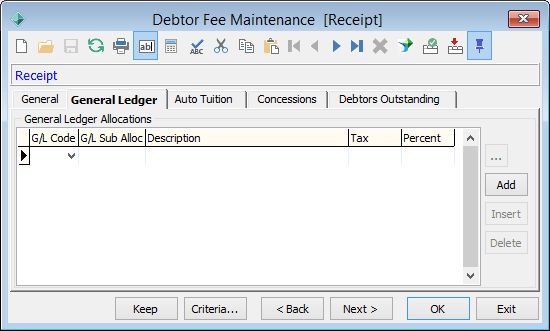
This allows a split of general ledger codes for a single fee code. This is required to enable boarding house meals to have tax included, without the amount for these meals being separated on the student's account. It will, however, allow a detailed tax invoice to be printed, showing the separate amount when this is required.
Debtor Charges Entry
Opening the Debtor Charges Entry window
To open the Debtor Charges Entry window:
- Add or select a debtor charges posting. Either:
• Select an existing posting. See Selecting existing debtor charges postings in the Debtors manual
• Add a new posting. See Adding new debtor charges postings in the Debtors manual.
The Debtor Charges Entry window is displayed. See Debtor Charges Entry in the Debtors manual.
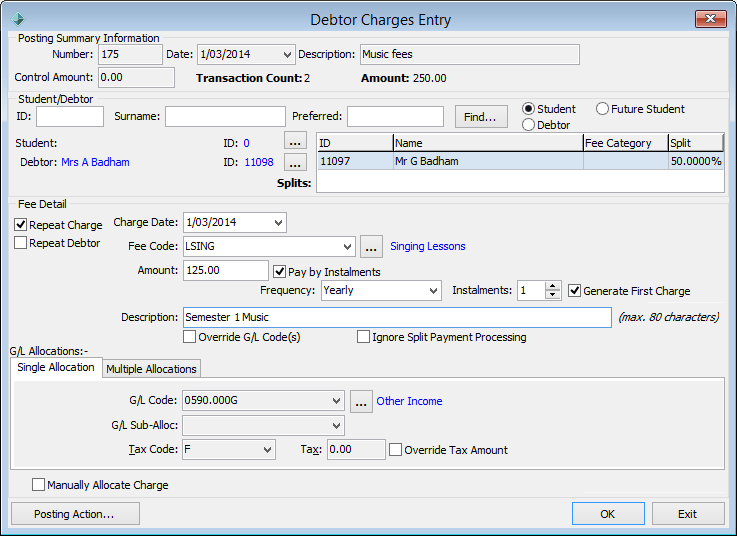
You can override:
- tax codes at the time that fees are charged to the student account
- general ledger codes and/or the tax code allocated
- general ledger splits if required.
Cash Receipts Entry - G/L Allocations tab
Opening the Cash Receipts Entry - G/L Allocations tab
To open the G/L Allocations tab of the Cash Receipts Entry window:
- First, enter payment details. See Debtor Cash Receipts Entry - Payment Detail tab in the Debtors manual.
- After selecting a posting from the Select Cash Receipts to Process window, click the G/L Allocations tab.
The G/L Allocations tab of the Cash Receipts Entry window is displayed.
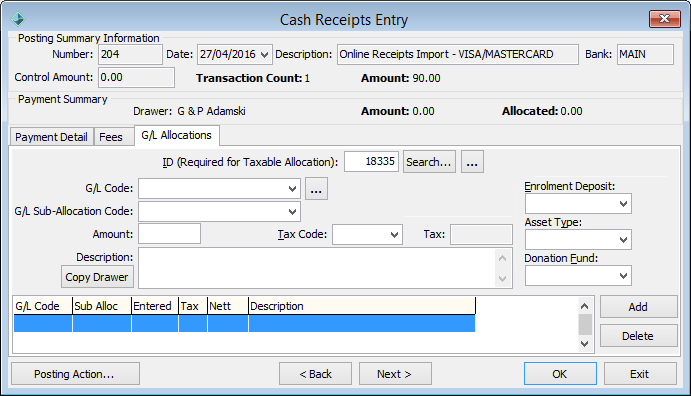
The fields Tax Code and Tax (amount) on the G/L Allocations tab need to be set. If the general ledger record for the account code selected allows tax codes to be changed then the Tax Code field are normal, otherwise it is inactive. Synergetic requires that all fees are priced to include tax.
If the general ledger receipt has a tax code, the receipt must be matched with a Synergetic community ID, depending on the minimum amount required.
Note: The minimum amount is set in the Min Cash Receipts G/L Allocation Amount requiring an ID field on the General tab of Finance Configuration Maintenance. See Synergetic Financial Configuration - General.
Creditor Maintenance - Account tab
Opening the Creditor Maintenance - Account tab
To open the Account tab:
- Select Module > Creditors > Creditor Maintenance from the main menu.
- Search for the creditor. See Searching for creditors in the Creditors manual.
- Click the Account tab. See Creditor Maintenance - Account tab in the Creditors manual.
The Account tab of the Creditor Maintenance window is displayed.
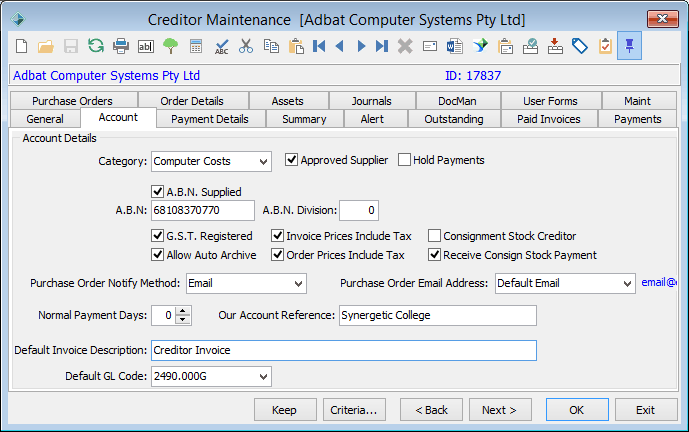
Field | Description |
|---|
Invoice Prices Include Tax | This is the default for all supplier invoices. It can be altered if a supplier prices their line items to exclude tax, with the total for GST added in at the bottom of the invoice. |
A.B.N. Supplied | In Australia, legislation requires businesses to withhold tax from payments to suppliers who do not provide an ABN.
Select if the creditor has provided their Australian Business Number.
If this field is not selected, Synergetic asks the user if they want to generate a withholding tax credit against the supplier's account.
This field can be directly set when entering invoices. |
A.B.N | ABN quoted on the supplier's invoice. This is for reference purposes. |
GST Registered | If this field is not selected, all general ledger journal entries in invoicing is marked as tax free. |
Creditor Invoice Entry - Invoice tab
Opening the Creditor Invoice Entry - Invoice tab
To open the Invoice tab:
- Either:
• Select an existing creditor invoice posting. See Selecting existing creditor invoice postings in the Creditors manual.
• Create a new creditor invoice posting. See Creating new creditor invoice postings in the Creditors manual.
The Creditor tab of the Creditor Invoice Entry window is displayed. - Select the creditor.
The Invoice tab of the Creditor Invoice Entry window is displayed. See Creditor Invoice Entry - Invoice tab in the Creditors manual.
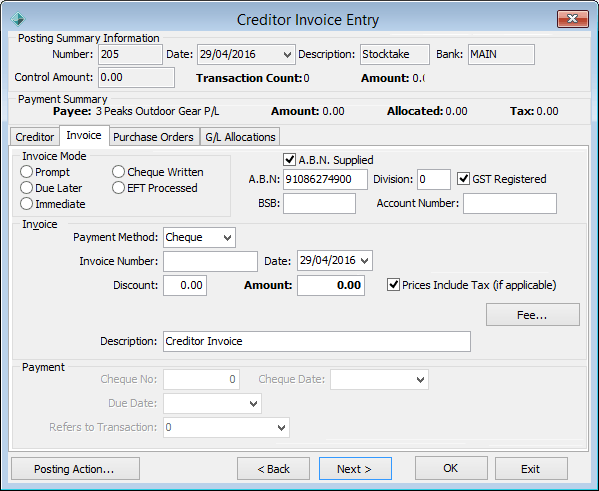
Note: The highlighted fields are only displayed if foreign currency is set up at your organisation.
.gif)
Field | Description |
|---|
A.B.N. Supplied | Is selected if you have previously indicated that the supplier has quoted their ABN.
Select this field if the ABN appears on the supplier's invoice. If the ABN Supplied flag is selected you can also enter or verify the actual ABN if required. |
GST Registered | If this field is not selected, allocations are marked as tax free. If you change this the creditor's master record is updated. |
Prices Include Tax | You can set this flag in the Account tab of Creditor Maintenance. See Creditor Maintenance - Account tab in the Creditors manual.
You can set or clear the flag while processing invoices but this will not change the default setting on the creditor's account. If the supplier's invoice line items each include tax (that is, your account allocations based on the invoice includes tax) then this field must be selected. This will ensure that only the amount nett of tax is actually posted to the expenses account. The tax amount is automatically posted to the Tax on Expenses Control account. |
Creditor Invoice Entry - G/L Allocations tab
Opening the Creditor Invoice Entry - G/L Allocations tab
To open the G/L Allocations tab of the Creditor Invoice Entry window:
- Either:
• Select an existing creditor invoice posting. See Selecting existing creditor invoice postings in the Creditors manual.
• Create a new creditor invoice posting. See Creating new creditor invoice postings in the Creditors manual.
The Creditor tab of the Creditor Invoice Entry window is displayed. - Select the creditor.
The Invoice tab of the Creditor Invoice Entry window is displayed. See Creditor Invoice Entry - Invoice tab in the Creditors manual. - Click the G/L Allocations tab.
The G/L Allocations tab of the Cash Receipts Entry window is displayed.
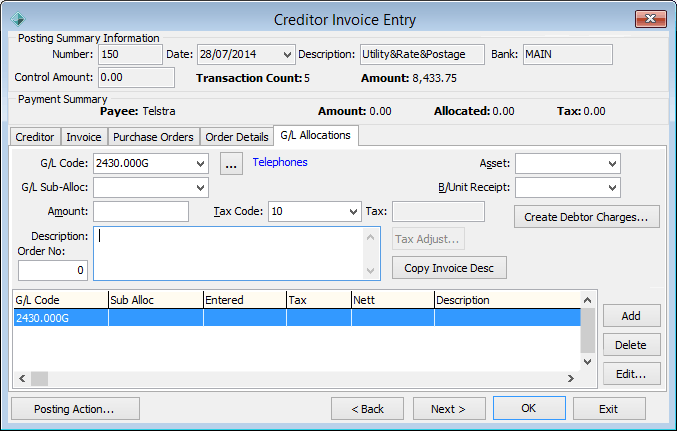
The Tax Code can be changed if allowed for this account. To check whether you are able to change the tax code:
- click
.png) next to the G/L Code field
next to the G/L Code field - check whether the Tax Code is Fixed field is selected on the General tab of General Ledger Maintenance.
If the invoice line items are priced excluding tax, you can get a rounding error between the supplier's calculation of tax and the Synergetic calculation. If this occurs, click Tax Adjust to post the rounding difference directly to the Tax on Expenses Control account.
Creditor Invoice Entry - Tax Withheld
If the supplier has not provided an ABN then you will be prompted for the action.

If you select:
- Yes then an automatic credit of 48.5% of the invoice value, allocated to the Tax Withheld Control account is posted against the supplier's invoice.
- No then no credit is posted. You should always withhold tax from suppliers who do not supply their ABN on invoices.
If a supplier does not have an ABN but tax does not need to be withheld, then select ABN Supplied and put a code in the ABN field. This ensures that the Tax Withheld window is not displayed. The code in the ABN field can be either:
- NA if withholding tax is not applicable
- an abbreviation for the reason that tax is not being withheld.
Creditor Invoice Entry - Audit Print of Tax Withheld
The audit report shows the automatic credit entry. See Creditor invoice posting actions in the Creditors manual.
.gif)
The report shows the total posted to the Creditor's Control account, with any credits deducted. It also shows the amount of automatically deducted credits and the original value of all invoices.
The original value of the invoices is the control amount for the posting.
General ledger journals
Opening the General Ledger Journals Entry window
To open the General Ledger Journals Entry window:
- Select Module > General Ledger > General Ledger Journals Entry from the main menu.
The Select General Ledger Journals to Process window is displayed. - Either:
• search for an existing journal
• create a new general ledger journal.
The General Ledger Journals Entry window is displayed.
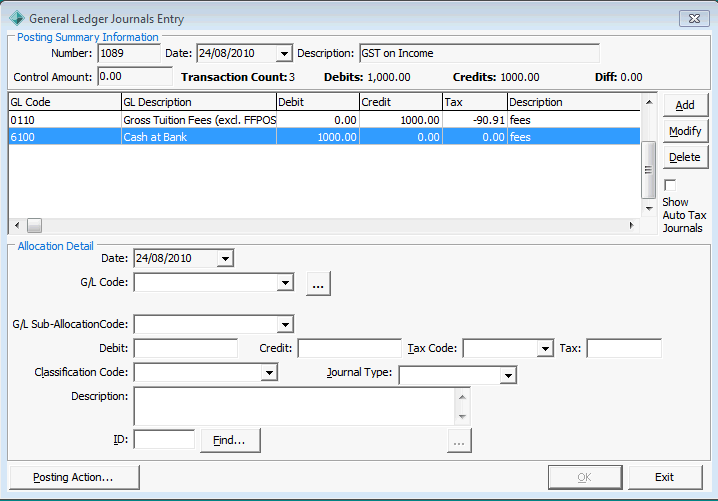
You can change:
- Tax codes.
- Classification codes. For example, define an asset sale.
- Journal type. For example, change income designation.
Finance Configuration - Business Units
Opening the Finance Configuration - Business Units tab
To open the Business Units tab:
- Select Module > System > Finance Configuration Maintenance from the main menu.
- Click the Business Units tab. See Synergetic Financial Configuration - Business Units tab in the Finance manual.
The Business Units tab of the Synergetic Financial Configuration window is displayed.
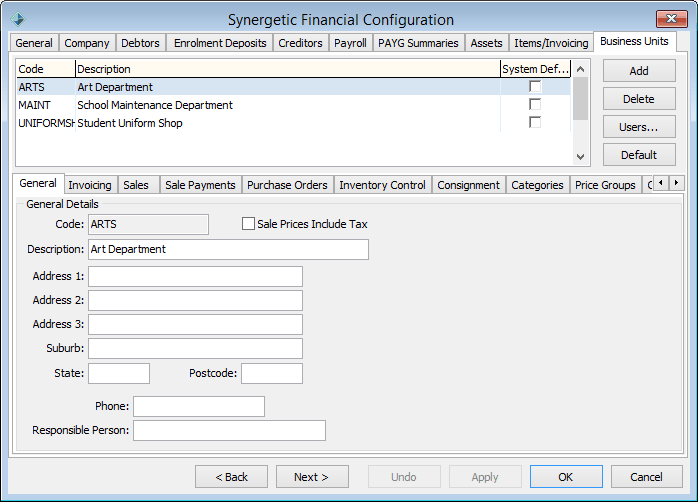
Define whether prices include or exclude GST.
Invoicing - Item Maintenance - Stock tab
Opening the Item Maintenance - Stock tab
To open the Stock tab:
- Select Module > Sales > Item Maintenance from the main menu.
The Set Item Search Criteria window is displayed. - Select the item. See Searching for items in the Sales manual.
The Item tab of the Item Maintenance window is displayed. - Click the Stock tab.
The Stock tab of the Item Maintenance window is displayed. - Select the business unit you are maintaining stock details for.
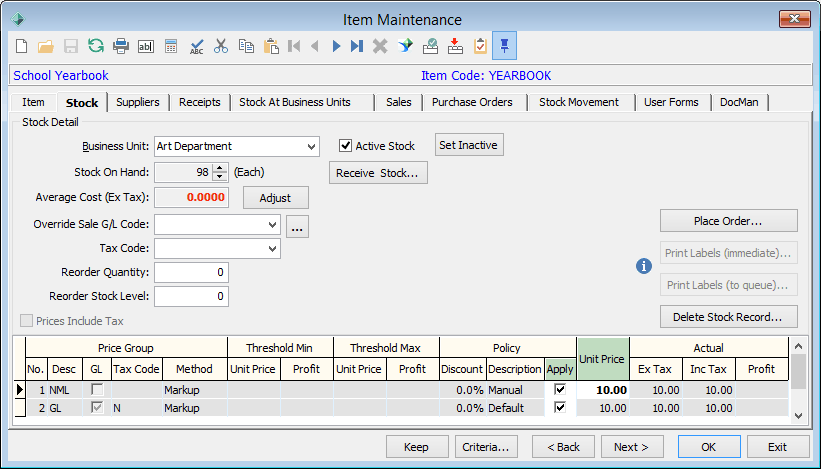
The Tax Code shows the default code for this item.
Invoicing - Sales Entry
Opening the Sales Entry window
To open the Sales Entry window:
- Select Module > Sales > Sales Entry from the main menu.
The Select Business Unit window is displayed if you:
• use business units at your organisation
• are authorised to access more than one business unit. - Select the business unit you are selling the stock items from.
- Click
 .
.
The New Sale window is displayed. - Select the customer. See Searching for a customer in the Sales manual.
The Sales Entry window is displayed.
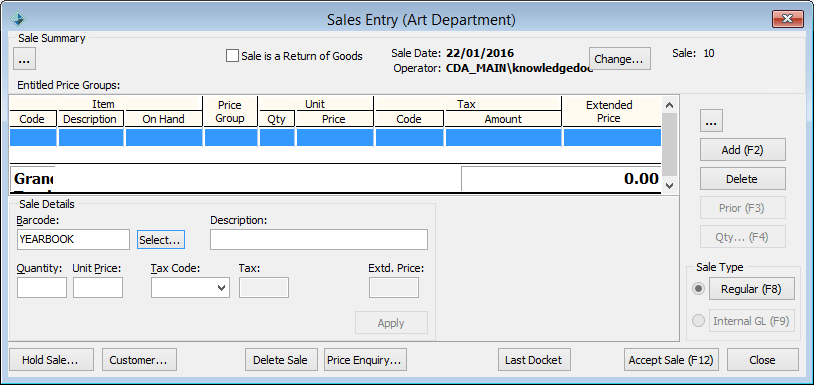
You can make a sale of the same item that in one circumstance may need to include tax, while in another needs to be exclusive of tax. The Tax Code field can be changed at the time that a sale is made.
.gif)







.gif)

.png)

.gif)




